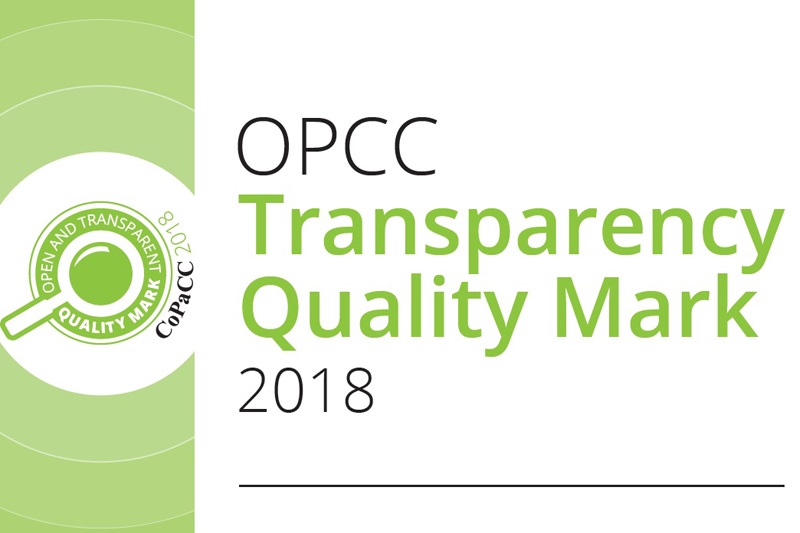“The public need independent, consistent and clear information on the performance and activities of their PCC. Transparency is essential to promote confidence in the elected PCC. A consistent minimum amount of evidence will also allow the public to compare the performance of their PCC with PCCs elsewhere.” – Home Office
Earlier today, PCCs, their Chief Executives and representatives from their offices gathered for a presentation of this year’s CoPaCC OPCC Transparency Quality Marks. CoPaCC first reviewed PCCs’ ability to meet their statutory transparency responsibilities one year after the first PCC elections, with a CoPaCC Thematic published in November 2013. As CoPaCC’s Chief Executive, I subsequently gave evidence on our Thematic’s findings to the Home Affairs Select Committee, where the Chair of the Committee suggested that CoPaCC might act as “a national register that just collates all this information together”.
This year’s presentations were hosted by the leading police assurance provider Grant Thornton.
Pictured are members of OPCCs receiving their Transparency Quality Mark certificates today, along with (from left) Paul Grady and Iain Murray of Grant Thornton, and Bernard Rix of CoPaCC.

Each year, CoPaCC invites each OPCC to provide us with details of how it meets the current statutory transparency requirements. We then undertake our analysis of the material we receive, along with our own desk research, and publish the results. I’m particularly grateful to my CoPaCC colleague, Sandra Andrews, for her work on this latest CoPaCC analysis. as well as her leading work on a related CoPaCC Thematic on OPCC Transparency, which will be published shortly.
Our original November 2013 Thematic sought information from OPCCs through a formal Freedom of Information request. Since then, we have deliberately NOT used Freedom of Information requests to gather this type of information, as we recognise that these create an additional – and, in this case, entirely unnecessary – burden on recipients.
The twenty five OPCCs awarded the CoPaCC “OPCC Transparency” Quality Mark at today’s presentations were:
- Avon & Somerset
- Bedfordshire
- Cambridgeshire
- Cleveland
- Derbyshire
- Devon & Cornwall
- Dorset
- Durham
- Gwent
- Hertfordshire
- Humberside
- Kent
- Leicestershire
- Lincolnshire
- Norfolk
- North Wales
- North Yorkshire
- Northamptonshire
- Nottinghamshire
- Staffordshire
- Suffolk
- Surrey
- Thames Valley
- Warwickshire
- West Midlands
Paul Grady, Head of Police for Grant Thornton who hosted the event, commented at the presentations that: “Transparency is an essential part of the democratic process. For the public to be able gauge how successful their PCC is in delivering their electoral mandate, they need access to information that is accessible, easy to understand and fit for purpose. Grant Thornton is proud to once again be hosting these Transparency Awards and we congratulate all those who have been successful in meeting the standards required.”
For my part, these OPCCs have all demonstrated that they are transparent in what they do, meeting relevant legal requirements. They present key information in an accessible format on their websites and I congratulate them all on their good work. I look forward to what I trust will be continued excellent work by each and every one of them in this area.
Bernard Rix
CEO, CoPaCC
Publisher, Policing Insight
CoPaCC contacted all OPCCs during 2017 requesting details of how they believed they met statutory transparency requirements. Most OPCCs responded, and we were able to confirm that those 25 OPCCs listed above met the statutory transparency requirements. However, our research in late 2017 indicated that a relatively small number of OPCCs failed to meet these required statutory standards. These OPCCs should contact CoPaCC again for further consideration, once they have made the appropriate improvements to their transparency arrangements. In addition, a small number of OPCCs did not respond to our statutory transparency invitation.Those that feel they meet statutory transparency requirements and wish now to be considered for the Quality Mark should contact CoPaCC without delay.



From personal experience the commissioner in my area is pretty invisible and yet appears on this list. I’m guessing that he’s published on an obscure website with a very low level of public awareness (I’ve checked and they have, a website apparently totally separate from the main website which is plastered over all policing literature).
In my opinion any assessment of “transparency” must take into consideration how “visible” the information is in terms of the public’s awareness of the location of it.
Publishing on a website that no one has an awareness of and which hence has very few “visitors” seems to me to be the modern equivalent of fulfilling a legal requirement to “publish” by posting on a noticeboard in the dark corner of an obscure location.
Do you know how many “views” these publications have had?
Many thanks for your feedback, Grant. You raise some good points.
As things stand, CoPaCC uses the Statutory Transparency Factors as the basis for our assessment. As their name suggests, these are not CoPaCC’s measures, but rather statutory – so PCCs and their offices must, by law, comply (even if some currently do not).
If we were to add any further criteria (such as ‘visibility’), these would by definition be CoPaCC additions, and not statutory requirements. Hence there would be more opportunity for PCCs and OPCCs to ‘push back’ on our assessment.
All that said, I can see considerable merit in what you suggest. I’ll ensure that CoPaCC bears this point in mind for our future Transparency work.
Many thanks for your thought-provoking comment!
Bernard
PS On your detailed, final question, we’re not aware of how many views PCC/OPCC websites get, not least as it’s not relevant to our (current) assessment methodology.